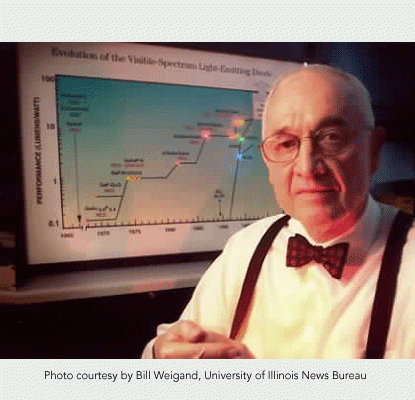Nick Holonyak
Demonstrating an affinity for electrical engineering in childhood, Nick Holonyak, Jr., invented the first practical LED (light emitting diode), the first visible-spectrum semiconductor laser and the household dimmer switch. His discoveries have had a major impact on the lighting industry, global communications, and consumer products, and thus earned him the $500,000 Lemelson-MIT Prize in 2004.
Used in digital readouts and to illuminate alarm clocks, coffee makers, traffic lights, billboards and more, LEDs may one day be used in lieu of fluorescent lighting in offices and homes. Considered the ultimate lamp, the longevity and efficiency of LEDs make them optimal for conserving energy.
Today’s LEDs, which come in several colors, evolved from Holonyak’s seminal work in 1962. At a time when other researchers focused on infrared light, Holonyak invented a method to synthesize gallium arsenide phosphide (GaAsP) crystals, which exhibited wavelengths in the visible spectrum. Using this "tunable" alloy, Holonyak crafted the first practical LED in 1962 (the red LED). “I wanted to work in the visible spectrum where the human eye sees, and everybody else was working in the infrared,” remarked Holonyak.
Holonyak also fabricated the first semiconductor laser from an alloy, GaAsP. The success of the GaAsP laser prototype made possible the development of red lasers used in CDs, DVD players and high frequency circuits in cell phones. Holonyak’s GaAsP alloy demonstrated that III-V alloys are viable. They are found in all high performance LEDs and lasers today.
In 1977 Holonyak developed the first quantum well semiconductor laser with student Edward Rezek. Such lasers are instrumental in global fiber optic communications systems, such as transmitting information over the Internet, in addition to surgery, materials processing and more.
In 1980 Holonyak and his students introduced impurity induced layer disordering (IILD) by intermixing the higher and lower energy gap layers of a quantum well crystal. IILD led to more reliable lasers, ideal for DVD players and CD-RAM drives. In 1990 he created native aluminum oxide technology, which has made vertical-cavity surface emitting lasers (VCSELs) practical for copy machines, laser printers and other communications.
Holonyak, born in Zeigler, Ill., received his BS (1950), MS (1951), and PhD (1954) in electrical engineering at the University of Illinois. Following military service and work at Bell Labs and General Electric, he returned to his alma mater in 1963 at the persuasion of his mentor, John Bardeen. He has advised 60 graduate students—eight have been elected to the National Academy of Engineering and many are now leaders in the optoelectronics industry.
Holonyak, who holds over 30 patents, is a member of the National Academy of Sciences, National Academy of Engineering, the American Academy of Arts and Sciences, and the Institute of Electrical and Electronics Engineers (IEEE), among others.
In addition to receiving honorary degrees, Holonyak has been recognized with numerous awards including the National Medal of Science (1990), the Global Energy International Prize (2003), the National Medal of Technology and Innovation (2003) and the IEEE Medal of Honor (2003). Most recently, he was awarded the 2021 Queen Elizabeth Prize for Engineering “for the creation and development of LED lighting”.
On April 20, 2005 Holonyak received the Order of Lincoln Medallion in Edwardsville, IL, which is awarded annually to six outstanding people who were born or have lived in Illinois. Holonyak was recognized for his light-emitting diode and semiconductor laser technology.


